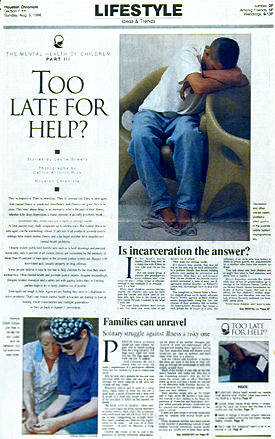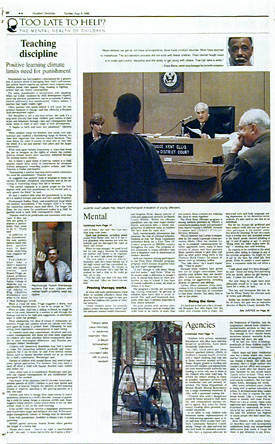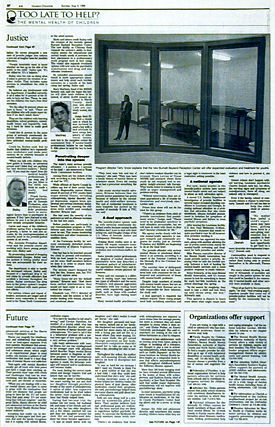By Leslie Sowers
In the mind's murky depths, there may well be a sharp line with Either on one side and Or on the other.
But one weary group of parents and grandparents loves children who crisscross the line - either victim or offender, therapy or jail, mentally ill or criminal - until it's a blur.
While their children receive therapy nearby, the relatives who care for them pass the tissues and share tales of children who light fires in the closet or put their hands through windows to see what it feels like.
They hope these children don't torture a pet, run away one more time or get thrown out of school. They hope the therapy works.
If it doesn't, they confide, they fear jail will be the next stop for their adolescents. In a political climate that favors building prisons over paying for prevention and treatment, their fears are well-founded. With 150,000 youths in the juvenile-justice system estimated to have at least one diagnosable mental disorder, an Either/Or nation may increasingly have to deal with Both.
The caregivers at Parent Talks, a Houston support group led by family advocate Sharon Brown, agonize as their children waver dangerously along the line, the sources of their problems still so visible: the hyperactivity disorder that keeps a child awake for 36 hours at a time, the influence of an uncle who was beaten to death by prison guards, the abandonment by a mother who runs the streets on drugs.
They talk about why their children are so angry they want to hurt someone, and about how to handle it.
Mercy Hamilton attends the group while four of her 30 grandchildren go to therapy at the Midtown Family Center of the Mental Health Mental Retardation Authority of Harris County. Her son is in prison; the four children's mother abandoned them; and Hamilton now has custody of them. Recently widowed, she faces their needs alone.
"I love these children, and I want to take care of them," she said. "But I get very little help with them."
Each has problems, including abuse issues from foster care, but it is her 6-foot grandson who worries her with his solitude and his disregard for rules at home and school.
When he was younger, he used to tell her he was angry because he wanted his mother and father to be together. At 15, he won't talk about his anger.
"He just takes it out on others," Hamilton said. He's been thrown out of his high school and has committed numerous minor offenses. He refuses to follow her structure. He's told her he wished he had a ship so he could go way out to sea.
"I'm the only one that will stay with him," she said. "After me, there's no one else."
Proving therapy works
As local and state governments crack down on youthful offenders, those who take the long view struggle to save programs that address the causes of criminal behavior.
"Often children enter the juvenile-justice system because they haven't gotten adequate mental-health treatment," said Regenia Hicks, deputy director of child and adolescent services for Harris County MHMR. "Within the offender population, you can have major mental illness, anti-social kids, a whole conglomerate of different types of children who have done the same acts." Early mental-health intervention can minimize the risk of criminal behavior. Banking on that, the Texas Legislature authorized funds for a First Time Offenders program at MHMR centers throughout the state. The program offers treatment to young offenders who have a diagnosis such as depression or conduct disorder.
Both are common among participants in the First Time Offender program, program, which focuses on parent training and anger management.
"It isn't enough to talk about things and feel better," said Hicks. "What we do should make a difference in people's lives. It should help them be more productive, to stay in school. If they have 12 violent outbursts a week, we want to reduce it to four." The program's results are encouraging. During treatment, 90 percent of children have been able to avoid re-arrest. Pre- and post-treatment measures show that 73 percent improved in their school behavior.
Because youths with serious emotional disturbances such as conduct disorder tend to be clients of more than one system, these systems are realizing the need to work together.
The First Time Offender program is among services provided by TRIAD, a consortium pooling funds and personnel from Harris County's MHMR, Juvenile Probation and Children's Protective Services divisions.
TRIAD director Joel Levine is responsible for the county's juvenile-crime prevention efforts. Often this involves trying to re-establish communication between aggressive teens, many of them victims of abuse, and their parents. Many parents refuse to pick their children up after police bring them to the Chimney Rock Center for minor offenses such as breaking curfew.
"You take them," he's heard repeatedly. "They're yours." Because these children have grown and are no longer controllable, their parents may believe they are incorrigible. In some cases, the teens have begun acting out aggressively, including attacks on parents and siblings. Levine offers intensive crisis intervention to try to reconnect y-ouths with their families. If that fails, he scrambles to find them shelter. Too often, they're lost to the street.
Doing the time
It's hard not to feel sorry for a 16-year-old Hispanic boy who lopes into the room and slumps onto a chair, his downcast eyes and body language oozing depression. In his detention-center uniform, it's also hard to see him as an individual.
But for his 16-year-old girlfriend and their unborn child, this boy isn't just another participant in yet another senseless drive-by shooting. To her, he's more than a homey who last attended school in the fourth grade, started drinking at age 10 and drugging at age 13, always "doing what the older dudes were doing" - stealing cars and brawling.
He expects to be certified in the adult system after failing to change in any of the juvenile programs. He might be out of jail by the time his child hits first grade. While he awaits a court appearance, a counselor visits his cell twice a week.
"I talk about what I've been through," he said. "About not being free and being with my family, about my girl having a baby. It takes the stress off me."
The only thing he might have done differently would be to stay out of his 'hood for a while, he said. This boy and thousands like him define for Elmer Bailey the ultimate unity of victim and offender.
Bailey has worked with these youths for 26 years, the past two as executive director of Harris County Juvenile Probation. He serves alongside a new slate of juvenile judges who enforce a new set of tougher laws for youthful offenders.
"People invariably want to know whether we line up on the side of the public or the child," Bailey said. "It's not either/or. It's a balance."
Bailey sees his role as doing what it takes to prevent the creation of another victim. That includes many services to rehabilitate the child in trouble.
He believes one involvement with his department, if handled correctly, is all it takes for 75 percent of his clients to turn out fine. These, he said, are the children who learn from their mistakes.
"It's the other 25 percent where we have to focus," he said. "These are the children who will create more victims if we don't watch them."
They are the children with learning disabilities, school problems, mental-health issues and impulsivity, making it hard for them to make good decisions.
Could this 25 percent be the same group of seriously emotionally disturbed children that advocates say have untreated mental-health problems?
Could be, Bailey said. But he doubts that children he's repeatedly seen misbehave and make poor choices do so entirely because of mental-health deficits.
"When you talk with children who have gotten in trouble, an untrained person won't think they are anything but bad decision-makers," Bailey said. "If you read the report from the mental-health professionals, it can sway you. If you just listen to the child, you think he made a really bad choice."
Frank Garns, chief psychologist for Juvenile Probation, also attributes such kids' problems more to sociological factors than to psychiatric diagnoses. If they have learned to misbehave, he sees it as his job to instill more socially acceptable behavior. Garns said many of the children's problems spring from a background of poverty, a factor he said also accounts for the overrepresentation of minority youth in the juvenile-justice system at all levels.
The Juvenile Probation department and the juvenile courts are working with more young people than ever, Bailey said.
By prosecuting instead of dropping misdemeanor charges, Bailey said, the system is letting youths know they are accountable for their actions.
The department is able to handle the increased volume, Bailey said, because of a significant drop in violent crime by juvenile offenders that parallels a decrease throughout the nation. Bailey attributes the drop here to the justice system's tougher stance combined with more prevention efforts.
For serious crimes and repeat offenders, sentences are longer and offenders more vulnerable to commitment to the Texas Youth Commission or the adult system.
Hicks and others credit Bailey with the creation of the recently opened Burnett Bayland Reception Center. The new facility on Chimney Rock expands the system's ability to thoroughly assess the educational and mental health needs of juveniles before placement in a probationary youth program such as boot camp. The center also expands treatment options with new units for psychiatric stabilization and drug and sex-offender treatment.
Its extended assessments should result in more appropriate placements and help avoid such terrible outcomes as a suicide at the boot camp last spring, Bailey said. Mary Martinez, head of the MHMR forensic unit, said she hopes the center will allow more children to be tested; of about 25,000 minors arrested in Harris County each year, only about 1,500 are currently tested, she said.
Judge Kent Ellis cited a recent case in which he was inclined to send a boy with a bad attitude to boot camp but, aware of emotional issues, sent him to the reception center for assessment first. If mental-health professionals believe he can handle it, Ellis plans to send the boy to boot camp.
Penetrating deeper into the system
The state's most serious juvenile offenders - 2 percent to 3 percent of the total - are sentenced to Texas Youth Commission facilities.
Among them are the sickest of the sick, according to Judy Briscoe, chief of staff for TYC.
While officials at Harris County facilities say few of their youths have serious, diagnosable mental illness, about 20 percent of TYC youths have major mental illness, including schizophrenia, bipolar disorder, major depression, organic brain syndromes and serious emotional disturbance. That's not counting the children with ADHD and conduct disorder, Briscoe said.
She has seen the severity of impairment as well as offenses increase in the last few years.
Before youths can participate in any resocialization program at TYC, Briscoe said, their treatment needs must be met. This means monitoring medications and other treatments to stabilize them.
At the Corsicana facility for seriously emotionally disturbed youths, the severity of illness frightens Briscoe.
One boy has to be watched around the clock to prevent self-mutilation. With his bare hands he has gouged out his veins. Staff members believe he does it in order to attack them when they intervene.
The system wasn't designed for kids like this, Briscoe said, but TYC can't turn anyone away.
"Many times we are the default system," Briscoe said. "Had there been earlier interventions, they would not have come to us or committed the crimes."
Elizabeth Lee, TYC's director of treatment, said the system is full of youths dealing with sexual, physical and emotional abuse. "They have seen lots and lots of violence," she said. "They may have a family history of mental illness or substance abuse. Every kid coming to us has a precursor something like this."
Like many mental-health advocates, Briscoe believes that the juvenile-justice population has grown because of failures by the mental-health and child-welfare systems. The end of residential treatment in state hospitals has pushed up the number of mentally ill kids at TYC, she said.
A dual approach
The juvenile-justice system ends up with seriously emotionally disturbed youths because mental-health facilities don't want to deal with their acting out, said Douglas Dodge of the U.S. Office of Juvenile Justice and Delinquency Prevention.
Helping these youths once in detention will require extensive cross-training in mental-health issues for probation and corrections staffers, he said.
Some juvenile-justice professionals are skeptical of conduct disorder, a psychiatric term that describes a consistent pattern of misbehavior. But psychiatrist Bruce Perry said research validates certain physical differences.
Perry said one example is a difference in resting heart rate between two types of offenders and the norm. Predatory, well-planned aggression correlates with low resting heart rates, while impulsively aggressive youth, such as those with conduct disorder, have high resting heart rates.
Many mental-health practitioners don't believe conduct disorder can be treated. Tracy Levins of Texas MHMR said research shows these youth do not respond well to empathic insight-oriented talk therapy. What works better is training in such skills as anger management and problem-solving.
"Without intervention, they are almost guaranteed a life of trouble for themselves and everybody else," Levins said.
Prison time alone will not do the trick for this group.
"There's no evidence from adult or juvenile (corrections) that punishment works," Dodge said. "There need to be graduated sanctions to hold offenders accountable, but we will have to work with them so they don't become criminals for life."
His agency works closely with federal mental-health agencies to support research and community programs for youths, just as Juvenile Probation and MHMR are beginning to do at the local level.
The juvenile offender with serious mental illness or emotional disturbance is an anomaly, according to a report of the National Coalition for the Mentally Ill in the Criminal Justice System.
The societal view of delinquent children as either sick or bad interferes both with treatment for the delinquent and punishment of those with mental-health problems.
Despite large numbers of youths with mental-health issues, few are so disturbed that their illnesses are totally responsible for their behavior, the study said.
A dual approach is required, the authors argued. These young people need both socializing sanctions and a legal right to treatment in the least restrictive setting possible.
A national agenda
For now, many youths in the juvenile-justice system have unmet mental-health needs and are subject to abuse as well, advocates agree.
A recent U.S. Justice Department investigation of juvenile facilities in several states revealed shocking conditions in Louisiana and Georgia, focusing national attention on a problem that advocates fear also exists elsewhere. Abuses included punishment in isolation for symptoms of mental illness and failure to treat psychotic symptoms.
After touring the Louisiana facility, U.S. Sen. Paul Wellstone, D-Minn., sponsored a measure that would require psychiatric care for all incarcerated juveniles needing it.
The Senate has approved the measure, along with another allowing the use of prison-construction money for mental-health screening and treatment for both juveniles and adults.
Mike Faenza, executive director of the Mental Health Association, has made juvenile justice a priority, decrying what he calls the terrible synergy between a lack of funding for mental-health services and a more punitive response to youth violence.
Betsy Schwartz, of the local Mental Health Association, said it's human nature to look for something to blame for such horrible incidents as the school shootings this spring.
"In the search for simplicity, they want to take a child and lock them up and throw away the key," Schwartz said.
This ignores a chance to learn more about what might cause such violence and how to prevent it, she said.
Violent crimes don't happen without warning, Louisiana psychiatrist Charles Zeanah said; but, too often, the warning signs and symptoms of maladjustment, there all along, are noticed only in retrospect.
Even if the family, school or community misses a chance to intervene early, Zeanah said it's not too late to help the older child or adolescent.
"No matter how awful a child's experiences may have been, putting them back in a care-giving environment that is sensitive to their needs is their best opportunity to get back on a more desirable developmental trajectory," Zeanah said.
Communities need to respond to cries for help before violence erupts, rather than trying only to protect themselves in its aftermath, Faenza said.
For every school shooting, he said, tens of thousands of juveniles are caught in the justice system for acts that could be handled in the community if mental-health and other services were available to them.
"They all go back to the community again," he said. "And creating angry, hopeless people that come out of juvenile-justice facilities will not be healthy for the community they re-enter."
Reprinted with permission of the Houston Chronicle, copyright 1998.



Please sign up below for important news about the work of The Carter Center and special event invitations.